The Fabric of Detroit: Uncovering Public Art
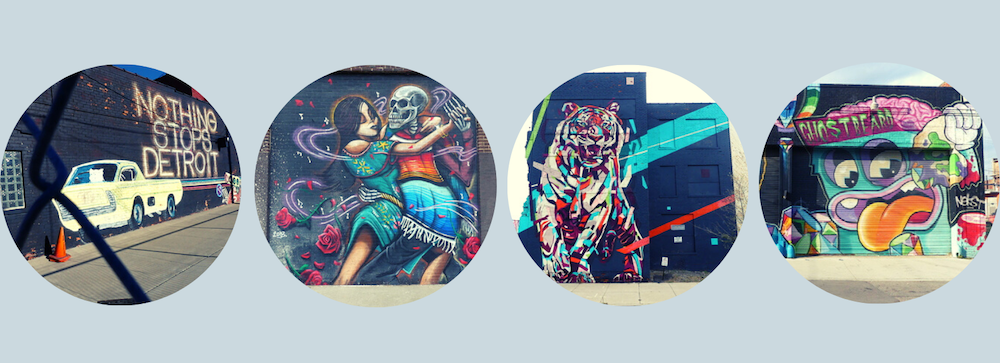
Meg Saligman's mural Common Threads weaves together a tapestry of colorful, larger-than-life portraits of contemporary and historic individuals. A commentary on shared humanity, the piece is an iconic landmark of Philadelphia’s Center City neighborhood and one of the approximately 4,000 murals that make up the city’s thriving public art scene. While living and working there, School of Information Sciences Associate Professor Joan Beaudoin continued her interest in public art that began with a research project on the Mexican muralist Diego Rivera during her undergraduate studies. She was inspired by the city’s growing number of murals and the work of Jane Golden, an artist and founder of Mural Arts Philadelphia. This organization began as a small city agency working with graffiti artists to collaborate on murals to transform long neglected neighborhoods and buildings and is now the largest public art program in the country.
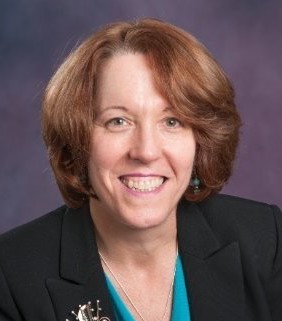
The city of Detroit is also known for its eclectic art scene and is often named among the top 10 cities in the U.S. for street art (including USA Today’s 2021 Top 10 Best Cities for Street Art), so when Beaudoin moved to Detroit more than a decade ago, the idea for a student project to document local artworks began to take shape.
“The murals are incredible cultural resources that speak to the vibrant artistic spirit of Detroit,” Beaudoin said. “When I’d drive around the city, I’d see murals and art installations and look for information online. There were some websites and apps, but they were often missing information like artist names and street addresses.”
The fragmented and inconsistent coverage of murals online and in publications over the years stood out as a need to Beaudoin, who received a bachelor’s degree in fine art from the Massachusetts College of Art and a master’s degree in art history from Temple University prior to earning a master’s and Ph.D. in information studies from Drexel University. “We should be doing something in the community to capture these wonderful works of art,” she continued. “We know that the arts can help turn a neighborhood around. People see the value of place and feel proud that they have art in their community that people like to see.”
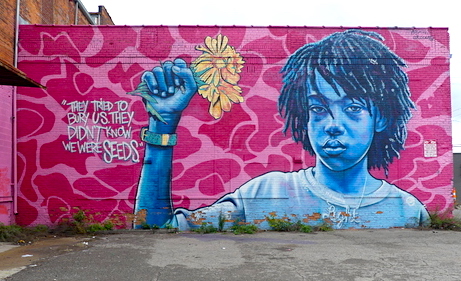
Although she had the idea to begin photographing and cataloging Detroit’s murals years ago, the tools and technical infrastructure weren’t available to Beaudoin at the time. The School of Information Sciences has since invested in a working version of Omeka, an open-source web publishing platform for sharing digital collections and online exhibits, for its students and faculty. Beaudoin now had the technology in place to provide this wonderful service to the community – she just needed the perfect student to partner with to make her vision come to life. The stars finally aligned when Cameron Socha logged in to her virtual classroom.
Under Beaudoin’s direction, students in the Digital Libraries class create their own small collections, usually consisting of 20 to 25 personal items. It is often the students’ first time creating a collection, so they work closely with Beaudoin on the labor-intensive process of digitally capturing and cataloging their items using Dublin Core, a metadata schema used to describe a variety of physical and digital resources. It’s a process that requires Beaudoin to meaningfully connect with her students to talk them through the digital collection development process and ensure they fully understand the steps involved.
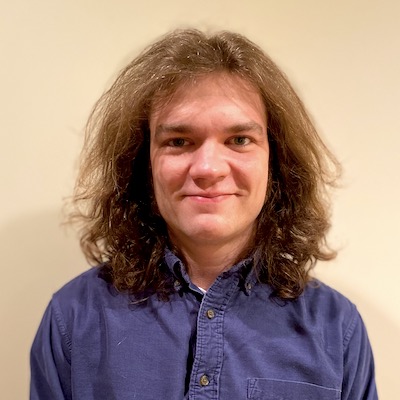
For the class, Socha created a digital exhibit of his parents’ European beer stein collection. Beaudoin, who had worked with Socha in several of her other classes, was impressed with his dedication and skills beyond the coursework. As Socha’s academic advisor, Beaudoin pitched the idea of having him catalog the city’s murals, starting in Detroit’s Eastern Market, as an individual three-credit directed study course (INF 7900).
“This project was right up my alley. I knew it would be something I would really enjoy,” said Socha. “It ended up being the most fun I’ve ever had in school.”
Socha said that he was interested in metadata and cataloging from a young age, even if he didn’t realize it at the time. Since childhood he enjoyed growing his personal collections of various media – records, cassette tapes, books, and comics—and buying and selling online, working within databases such as Goodreads, Comic Book Roundup, Discogs and more.
After receiving a bachelor’s degree in English from the University of Michigan, Socha began working at Barnes and Noble and became interested in the behind-the-scenes aspects of the store and working with the company’s database. “Working with metadata is something I always wanted to do, but I didn’t know where to start. I thought I was pretty good at organizing my own collections, but I wanted to learn how to do it to help others,” Socha said. What began as a hobby inspired Socha to enroll in the School of Library and Information Sciences at Wayne State in 2019.
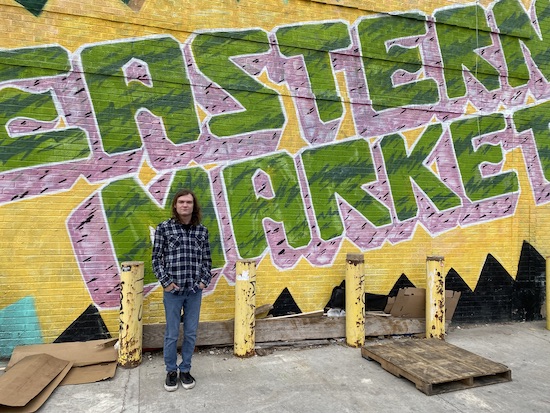
With a knack for computers, Socha decided to focus his degree on the Digital Content Management specialization within the program. When he approached Beaudoin to inquire about an additional database design course, she delivered the pitch about the mural project and the pair hit the ground running. Only two weeks into the semester Socha and Beaudoin met in Eastern Market to start to map out their plan – literally creating an interactive map within Omeka that can be accessed by users to discover the murals in the area.
They decided to focus on a five block by five block area of Eastern Market to start, which includes an astounding 111 murals in the relatively small area of the city. Socha began by taking photographs of each mural and gleaning whatever information he could from the artwork itself. Some murals and artists, especially those created for Murals in the Market, Eastern Market’s annual public art festival, were easy to identify, while others were more elusive.
Reaching out to the tight-knit communities of artists on Instagram helped Socha discover more about many of the artists, their works, and the inspirations behind them. “It’s an artform that is often underappreciated and a bit underground. It’s a passion for most of the artists – the passion of creating something beautiful to share with the community.”
Socha plans to continue contributing to the collection even though the directed study with Beaudoin is over. He is proud to have established a foundation from which other students can work in future collaborations. To ensure a seamless transition, Socha created tutorials to guide students in how to use the mapping and exhibit features in Omeka.
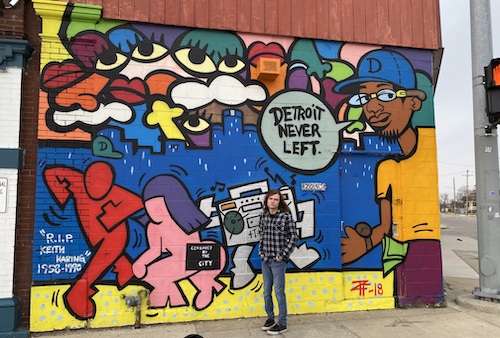
“It was great working with Dr. B. She really provided a balance between keeping the project a directed study, but also an independent study,” Socha said. “She was great at allowing me the freedom to make big decisions regarding the project, but if I ever ran into trouble and felt lost or stuck, I was able to reach out and she was very helpful in getting me back on track.”
Socha, who will graduate with a master’s degree in library and information science in spring 2022, recently began his first job as a branch assistant for the Marine City Public Library. He hopes to one day work as a metadata librarian or digital collections manager.
Beaudoin looks forward to seeing the collection eventually expanded to include other works of public art, including sculptures and art installations.
“Detroit is known as a place where individuals have the opportunity to live in a vibrant artistic community. That spirit to create is part of the fabric of Detroit. That’s what makes this city so great across its history,” she said. “Historical narratives are woven into the imagery of what’s displayed in the neighborhood.”
Although he says the project was overwhelming at times, Socha is also excited to see how it will continue to grow into the future. “The biggest satisfaction I got out of the project was when I heard back from the artists,” he said. “If just one person sees this map and thinks, ‘I want to go see these murals in person,’ I’ll feel like this project was a success.”
View Socha’s Detroit Mural Map exhibit here.
The murals pictured at the top of this page are:
- Untitled ["Nothing Stops Detroit"] by Ryan Doyle, Murals in the Market 2015
- Fiestas de Enero by Freddy Diaz, Murals in the Market 2018
- Untitled [Multicolored tiger] by Arlin Graff, Murals in the Market 2017
- Untitled [Ghosts with rucksack, brain hat, and diamonds] by Patch Whiskey and Ghostbeard, Murals in the Market 2016